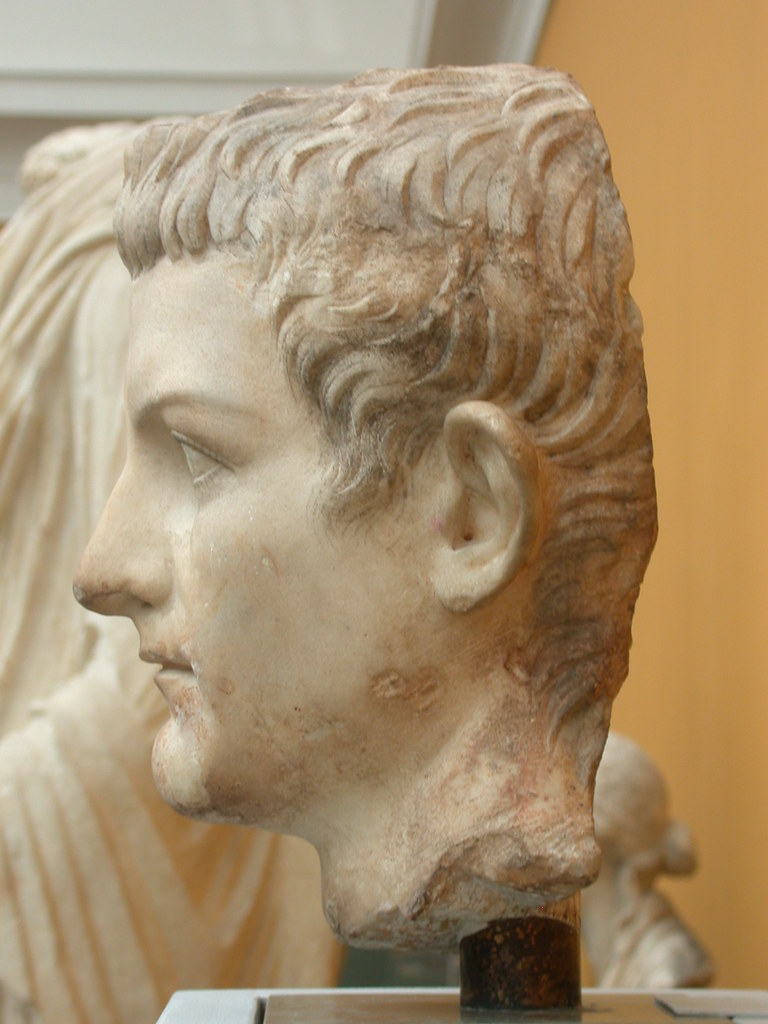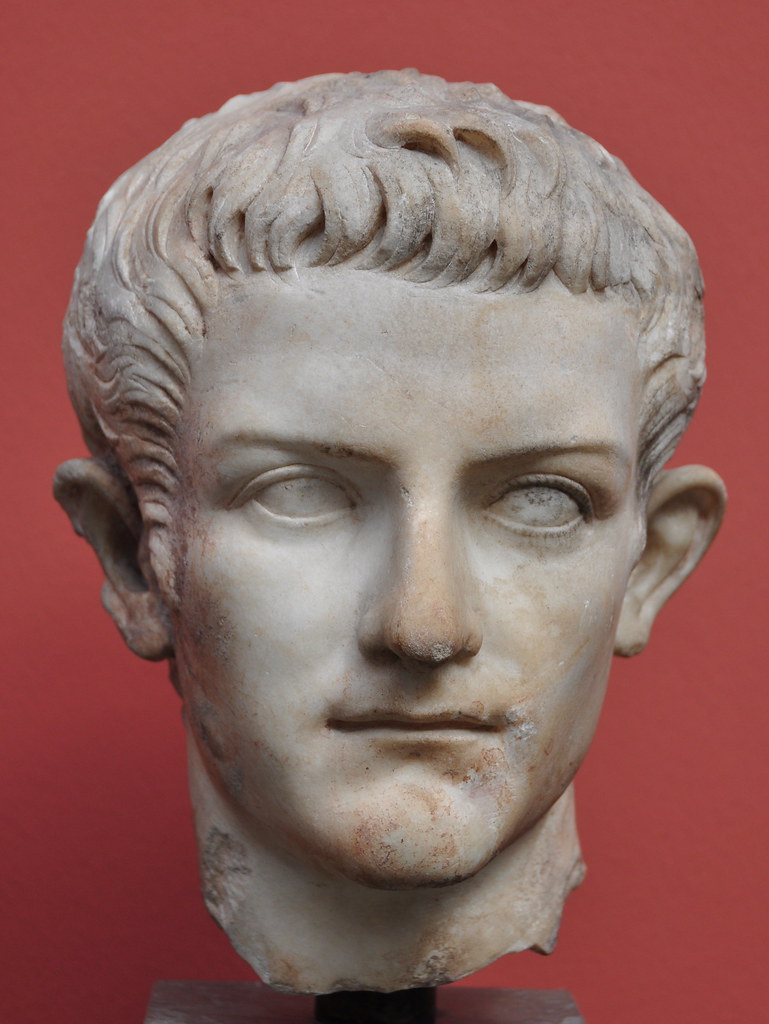The Portraiture of Caligula in Right Profile - AR Denarii: The Imagery and Iconography
By Joe Geranio

For some time now I have been fascinated with the portraiture of Caligula in the round! He has typically been portrayed in the round (typology)1 and his physiognomy as described below. Most of these portraits are based upon official portraits, we can assume as Caligula (Princeps) wished to be portrayed. Some twelve to 30 sculptural likenesses of Caligula have survived,2 but these identifications can be quite subjective due to familial assimilation.
Caligula 's characteristics typical are: Hair low on the nape of the neck, protruding upper lip, deeply set eyes, hollow temples, of course not apparent on profiles on coins, and a vertical or sloping forehead, unlike his father Germanicus which is vertical. The silver denarii which we are focusing on are all in right profile. Von kaenel the author of Munzpragung und Munzbildnis des Claudius, AMuGS9 (Berlin 1986), as well as an article on Caligula 's coinage, "Die Organisation der Caligulas." RSN66 (1987). pp. 135-56. I disagree with some art historians as whether a portrait of a particular Princeps was copied from a portrait medallion, I believe it would have been a portrait in the round the die-engraver would have first been copied from. The right side from one portrait model from an imperial commission for precious metals and the left side for the bronzes.

The silver denarii of Caligula shows the right profile (only) as having the hair low on the nape of the neck and begs the question what is the difference between the right and left profile iconographically to portraits in the round, and if we take Caligula 's right profile from the AE asses and Sestertii do they agree with extant portraits of Caligula in the round? von kaenel: The author of Munzpragungund Munzbildnis des Claudius, AMuGS9 (Berlin 1986) as well as an article on Caligula 's coinage, "Die Organisation der Caligulas." RSN66 (1987), pp. 135-56, I am leaning heavily as von Kaenel, that there was some model in the round that a die-engraver would copy. It will take some time and I need to look at coinage of other Princeps, but if for example you look at the NY Glyptotek head of Caligula from Copenhagen in right profile it follows the hairstyle very closely.
Here is another example of the 5 curls and hair low on the nape of neck.


I am now starting to look at Aes and will see the left profile and if there is any consistency. I am looking to see if there may be a mint signature by either looking at the right and left profiles? I do not agree with von Kaenel that that the identification of Caligula 's precious-metal mint has little significance for the analysis of the emperor 's portraits on coins.From Kleiners Review of Boschung.3 In the case of Caligula 's portraits, Boschung was fortunate in having von kaenel as his partner. The author of Munzpragungund Munzbildnis des Claudius, AMuGS9 (Berlin 1986) as well as article on Caligula 's coinage, "Die Organisation der Caligulas." RSN66 (1987), pp. 135-56, written at the same time as his RomischeHerrscherbild text. Von Kaenel 's chapter in Die Bildnisse de Caligula (pp.13-26) treats the official coinage ("Reichspragung") exclusively. Other coins bearing the portraits of Caligula (Provinzial-und Lokalpragung") are not examined. They are, in the opinion of von kaenel (and I concur), more valuable as documents of the "Rezeption" of imperial imagery in the provinces than as a means of defining the official portrait types themselves (p.16) Gold,silver, and aes coinage are, however, all studied. The portraits of Caligula on the aurei and denarii are all in right profile; those on the sestertii, dupondii, and asses are all in left profile. Von Kaenel concludes that all of the imperial issues reproduce a single official portrait type and that what variations exist are of a stylistic and not of a typological nature. Furthermore, since the two profile views are not mirror images, von Kaenel suggests that they faithfully reproduce the left and right side respectively of a single model in the round and he believes that the comparison with marble replicas of Boschung 's "Haupttypus" confirm that the same same master "Vorbild" lies behind both the sculptured and numismatic replicas. According to von Kaenel, the Roman die engravers were provided with either a single head in the round to serve as a model for their miniature profile portraits or with two separate relief portraits corresponding to the left and right sides of a sculptured head of Caligula 's " Haupttypus." This is an important observation and it would be interesting to know if it is typical of Roman numismatic portraiture for left- and right-facing portraits of the same person to be rendered differently or whether the coinage of Caligula is exceptional in not employing mirror images. Whatever the answer to the larger question, Caligula 's coins unfortunately cannot be cited as incontrovertible evidence that Roman die engravers had models in the round from which some copied the left profile and others the right profile. Von Kaenel assumes that the coins he has collected and analyzed are almost exclusively product of the imperial mint at Rome, but there is a growing consensus that while Caligula 's aes issues were struck in the capital, the bulk if not all of his gold and silver coinage was produced at Lugdunum (Lyons). (See, sot recently, WE. Metcalf, "Rome and Lugdunum Again," AJN 1 [1989],pp. 51-70.) The fact that Caligula 's left and right profile portraits on coins are different might mean that both mints worked from portrait models of the same type-the selection of one profile or the other could then be a kind of mint signature-but it could also indicate that one portrait was copied in the capital and another one Gaul. It therefore cannot agree with von Kaenel when he states (p.17 n.10) that the identification of Caligula 's precious-metal mint has little significance for the analysis of the emperor 's portraits on coins. In the main section of Die Bildnisse des Caligula, Dietrich Boschung discusses the portrait sculpture of the emperor and the relevant literary and epigraphical evidence (pp. 27-103) and catalogs all known Caligula portraits, both in the round and on gems, including those refashioned as images of Claudius (pp. 105-24). Much of Boschung 's discussion falls outside the realm of a review in a journal of numismatics.4

Caligula Ny Glyptotek Frontal View (Photo Courtesy Pollini)
The silver denarii of Caligula agree more with the Copenhagen head then any other head I have seen. The frontal view which can 't be seen on his coinage show the triangular face, and an impression type fold of the skin in the forehead. This is of course of little iconographic evidence for the Caligula denarii unless we look at the all important right profile. Caligula 's hairstyle also has a nearly closed pincer above the right corner of the eye which is typical of his hairstyle. This to me is one of the finest portraits of Caligula in the round that is extant. If we start at the center and count the curls you will see the same 5 that exists on the silver denarii of Caligula.
1. Joe Geranio, Portraits of Caligula: The Seated Figure?; Society of Ancient Numismatics, Vol. XX. (1997)
2. John Pollini- For more on Typology see: A Pre-Principate Portrait of Gaius (Caligula) JWAG (1982)
3. D. Boshung- Die Bildnisse des Caligula, Gebruder Mann (Germany 1989)
4. Fred Kleiner, American Journal of Numismatics 3-4, (1992) pp. 233-38. Kleiner has some great thought on left and right profile which come from von Kaenel. See note 3. for more on von Kaenels theory.












